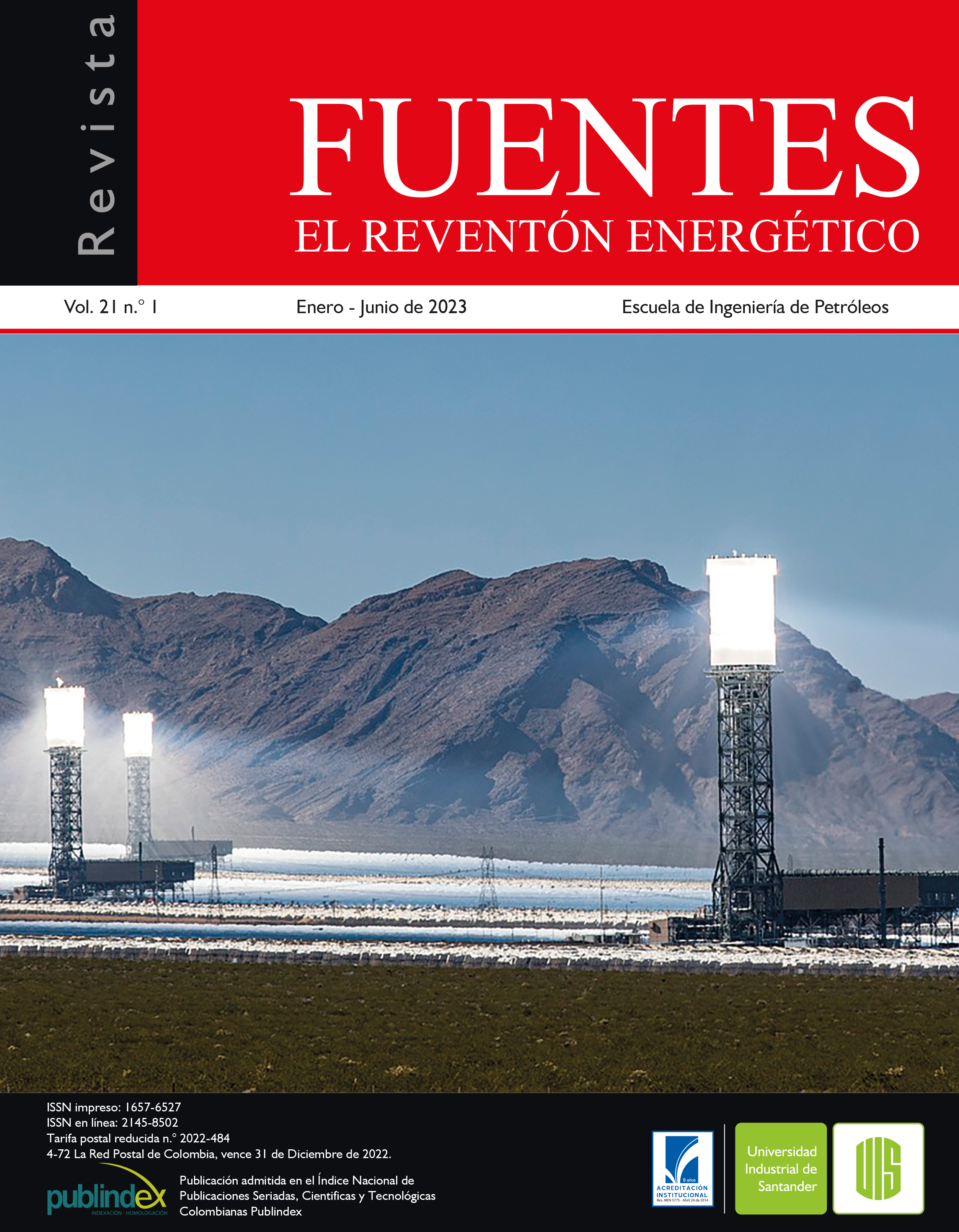AVALIAÇÃO AUXILIADA POR COMPUTADOR DA EXTRAÇÃO POR SOLVENTE PARA HIDROCARBONETO LEVE USANDO DIÓXIDO DE CARBONO
Publicado 2023-04-20
Palavras-chave
- Desenho assistido por computador,
- extração,
- hidrocarboneto,
- dióxido de carbono,
- simulação
- processo ...Mais
Como Citar

Este trabalho está licenciado sob uma licença Creative Commons Attribution 4.0 International License.
Resumo
Diferentes processos de separação são usados na indústria química, em particular, a extração é um processo usado para aumentar a qualidade das resinas no óleo removendo impurezas como sólidos orgânicos e metais pesados. O dióxido de carbono supercrítico oferece alta seletividade ao final do processo de extração de hidrocarbonetos leves da mistura de óleos pesados. Uma técnica de simulação no software Aspen Plus ®foi utilizada para desenvolver o processo e a análise de sensibilidade da configuração da extração. A simulação do processo de extração inclui dois fluxos de saída: o primeiro, um fluxo superior (óleo não pavimentado) e o segundo um fluxo inferior (resíduos asfálticos). Uma metodologia de estado estacionário foi implementada para simulação de processos. A análise de sensibilidade foi utilizada para avaliar a influência de variáveis como: vazão do solvente, temperatura e pressão. Foi constatado um aumento significativo na vazão de óleo quando a vazão de solvente é aumentada. Os valores ótimos de extração foram selecionados dependendo dos efeitos da temperatura e pressão sobre o processo. Um aumento na temperatura aumenta diretamente a qualidade da gravidade API. Em certas ocasiões, um aumento de pressão afeta a extração de óleos leves devido ao arraste do produto.
Downloads
Referências
- Abdulredha, M.M., Hussain, S.A., & Abdullah, L.C. (2020). Overview on petroleum emulsions, formation, influence and demulsification treatment techniques. Arabian Journal of Chemistry, 13 (1), 3403-3428. https://www.sciencedirect.com/science/article/pii/S1878535218302442
- Ahn, S., Shin, S., Im, S.I., Lee, K.B., & Nho, N.S. (2016). Solvent recovery in solvent deasphalting process for economical vacuum residue upgrading. Korean Journal of Chemical Engineering, 33(1), 265–270. https://link.springer.com/article/10.1007/s11814-015-0146-3
- Budisa N., & Schulze-Makuch, D. (2014). Supercritical Carbon Dioxide and Its Potential as a Life-Sustaining Solvent in a Planetary Environment. Life, 4(3), 331–340. https://www.mdpi.com/2075-1729/4/3/331
- Cárdenas, V.O.C. (2010). Estudo experimental e modelagem matemática da separação de asfaltenos e óleos lubrificantes provenientes do resíduo de petróleo por desasfaltação supercrítica. Universidade Estadual de Campinas. https://repositorio.unicamp.br/acervo/detalhe/782233
- De Souza R. A., De Oliveira A. A., Vieira Y. M., Zaparoli A. T., Wolf Maciel, M. R., Filho R. M., & Cárdenas-Concha, V. O. (2017). Sensibility analysis of propane deasphalting process variables. Petroleum Science and Technology, 35(1), 22–29. https://www.tandfonline.com/doi/abs/10.1080/10916466.2016.1225086?journalCode=lpet20
- Eckermann B., & Vogelpohl, A. (1990). Deasphaltization and demetalling of heavy crude oils and distillation residues with CO2. Chemical Engineering & Technology, 13(1), 258–264. https://onlinelibrary.wiley.com/doi/abs/10.1002/ceat.270130135
- Espinoza, S.N. (2001). Procesamiento supercrítico de productos naturales. Modelado, análisis y optimización. Universidad Nacional del Sur. http://repositoriodigital.uns.edu.ar/handle/123456789/2181
- Freitas A., Santana C., Silva R., & Silva, G. (2007). Investigação das facilidades e métodos utilizados atualmente no processamento primário de petróleo em campos onshore e offshore. 4o PDPETRO, 1–8. http://www.portalabpg.org.br/PDPetro/4/resumos/4PDPETRO_2_3_0322-1.pdf
- Grziwa. (1982). The chemistry and technology of petroleum: by James G. Speight Marcel Dekker, New York, Fuel Processing Technology, 5(3–4), 325–326. https://www.sciencedirect.com/science/article/pii/0378382082900261
- Holderbaum T., & Gmehling J. (1991). PSRK: Eine Zustandsgleichung zur Vorhersage von Dampf/ Flüssig‐Gleichgewichten bei mittleren und hohen Drücken. Chemie Ingenieur Technik, 63(1), 57–59.
- Hosseinifar, P., Shahverdi, H. (2021). A predictive method for constructing the distillation curve of petroleum fluids using their physical bulk properties. Journal of Petroleum Science and Engineering, 200, 108403. https://doi.org/10.1016/j.petrol.2021.108403
- Leal-Navarro, J., Mestre-Escudero, R., Puerta-Arana, A., León-Pulido, J., & González-Delgado, Á. D. (2019). Evaluating the Exergetic Performance of the Amine Treatment Unit in a Latin-American Refinery. ACS Omega, 4(26), 21993 –21997. https://pubs.acs.org/doi/10.1021/acsomega.9b03051
- Li, J., Fischer, K., & Gmehling, J. (1998). Prediction of vapor–liquid equilibria for asymmetric systems at low and high pressures with the PSRK model. Fluid Phase Equilibria, 143(1–2), 71–82. https://www.sciencedirect.com/science/article/abs/pii/S0378381298002064
- Liu, Z.M., Yang, G.Y., Lu, Y., Han, B.X., & Yan, H.K. (1999). Phase equilibria of the CO2–Jiangsu crude oil system and precipitation of heavy components induced by supercritical CO2. The Journal of Supercritical Fluids, 16 (1), 27-31. https://www.sciencedirect.com/science/article/abs/pii/S0896844699000182
- Martins S., Azevedo M., Silva M., & Silva, V. (2015). Produção de petróleo e impactos ambientais: algumas considerações. HOLOS, 6, 54-76. https://www2.ifrn.edu.br/ojs/index.php/HOLOS/article/view/2201/1212
- Mathias, P.M., & Copeman, T.W. (1983). Extension of the Peng-Robinson equation of state to complex mixtures: Evaluation of the various forms of the local composition concept. Fluid Phase Equilibria, 13, 91-108. https://www.sciencedirect.com/science/article/abs/pii/0378381283800843
- Peng, H., Yang, J., Peng, J., Han, H., Gou, X., Jia, Y., Li, Y., & Kadet, V. (2022). Influence of supercritical CO2 on the physical property of tight sandstone. Petroleum. https://www.sciencedirect.com/science/article/pii/S2405656122000645
- Pulido, J.L., Martinez Arias, E.L., Wolf Maciel, M.R., & Maciel Filho, R. (2011). Heat Integrated Reactive Distillation Column (r-HIDiC): Implementing a New Technology Distillation. Chemical Engineering Transactions, 24, 1303- 1308. https://www.cetjournal.it/index.php/cet/article/view/CET1124218
- Riazi, M.R. (2005). Characterization and properties of petroleum fractions. ASTM International. https://www.astm.org/mnl50-eb.html
- Rincón, F.D. (2009). Representação do petróleo através de componentes reais para a simulação de processos de refino. Universidade de São Paulo. http://www.teses.usp.br/teses/disponiveis/3/3137/tde-18082009-142836/es.php
- Rudyk, S., Spirov, P., Al-Hajri, R., & Vakili Nezhaad, G. (2017). Supercritical carbon dioxide extraction of oil sand enhanced by water and alcohols as Co-solvents. Journal of CO2 Utilization, 17, 90–98. https://www.sciencedirect.com/science/article/abs/pii/S2212982016304449
- Wilson, R.E., Keith Jr, P.C., & Haylett R.E. (1936). Liquid propane: Use in Dewaxing, Deasphalting, and Refining Heavy Oils. Industrial and Engineering Chemistry, 28(9), 1065–1078. https://pubs.acs.org/doi/10.1021/ie50321a022
- Yuan, Q., Zhang, Y., Wang, T., & Wang, J. (2023). Characterization of heavy metals in fly ash stabilized by carbonation with supercritical CO2 coupling mechanical force. Journal of CO2 Utilization, 67, 102308. https://doi.org/10.1016/j.jcou.2022.102308
